For the Love of Paper - A Thai Adventure
I love paper. As with any art material - brushes, paint, whatever - the quality of the art product helps determine the quality of the project you are completing.
For example, a few years ago I was asked to teach an art class for children at a local youth camp; organizers agreed to provide the art supplies, tables, equipment, and even some volunteers to help the students. All I had to do was teach.
The lesson - based on ArtAchieve’s lesson, “The Kitenge Tree Wall Hanging from Tanzania” - involved painting with watercolors, so I specified my favorite crayons, drawing paper, watercolors, and watercolor brushes. When I arrived to teach, however,
-
the “drawing paper,” was thin printer paper, and
-
the “watercolor brushes” had wiry bristles that were so stiff they tore the paper.
It was too late to get replacement supplies, so I proceeded with the lesson. Students were happily involved as they drew and colored with their crayons, but when they applied watercolors to create a batik effect, the paper started tearing, and soon each student was left with a soggy shredded mess.
An experience like that is a good reminder that the kind of paper we use in an art project is really important; it puts me on a constant lookout for new paper products. It’s fun to see how they affect my art work. So you can imagine how exciting it was when our guide in Thailand drove us to the Elephant Poopoo Paper Park!
|
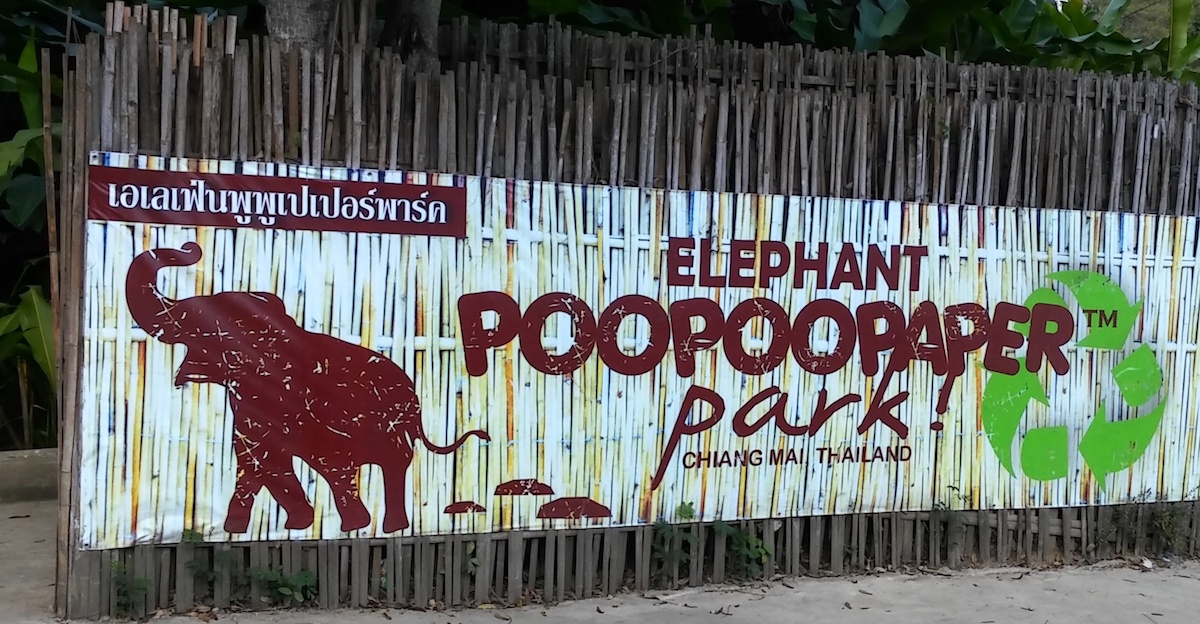
|
|
Entrance to the Poopoo Paper Park
|
Thailand has 3000 elephants living on elephant farms, and somehow the country needs to pay for their feed. They have enormous appetites. Thai elephants eat grass, and it takes them only 2 hours to digest a meal before it’s bathroom time.
With such a short digestion time, only 40% of the grass is digested; the rest is eliminated. So one way to pay for elephant upkeep is to turn the elephant poo and all that undigested grass into poopoo paper. (That’s poopoo paper for art projects, not for the bathroom!)
It sounds disgusting, though, and our first question was, “Does the paper smell?” The park attendant assured us it did not and then took us on a tour of the park to show us a process whereby Thai people turn poo into paper. The tour was in a park, so industrial scale processing what not what we were going to see. This was a concept tour. Industrial scale production would be taking place elsewhere.
|

|
|
Our park attendant with a lump of dried poo
|
Standing in front of bags of dried poo, the ranger offered us a chance to to feel and smell the read-for-processing poo. To be honest, it seemed pretty inert and really did NOT smell at that point.
So off we went to the next stage of processing: poo washing! During this first stage of the process the poo is boiled, cleaned, and rinsed.
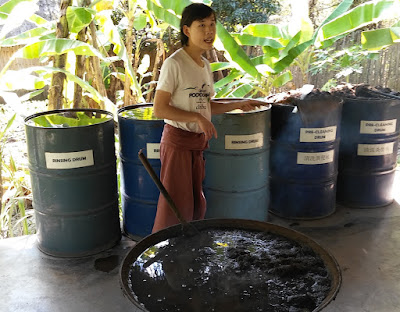
Each of us got a turn stirring the boiling pot. It felt a bit like a scene from Macbeth: "Round about the cauldron go . . .Double, double, toil and trouble, Fire burn, and cauldron bubble!"
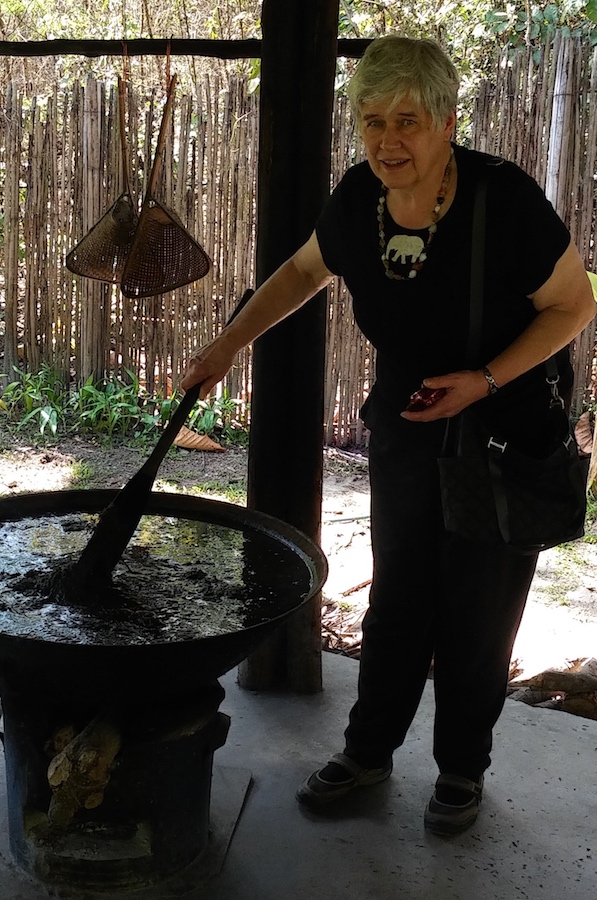
When the boiling, washing, and rinsing stages are finished, only the undigested grass fibers remain.
Next, the undigested grass fiber -
-
along with some plant dyes (These paper makers are purists: no chemical dyes or bleaches!)
-
and tough fibers from mulberry trees -
get sloshed together in a big mixing tub. The mulberry fibers add strength to the paper.
|
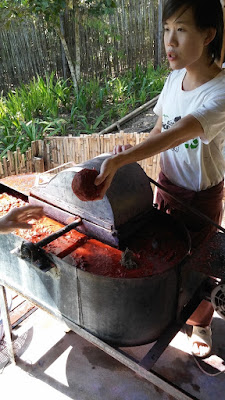
|
|
A mixing tub with dye and mulberry fiber added to the poo
|
When the slurry is completely blended and pudding-like, the slurry gets spread out on a screen, and the screen with its paper mush coating are set out in the sun to dry.
|
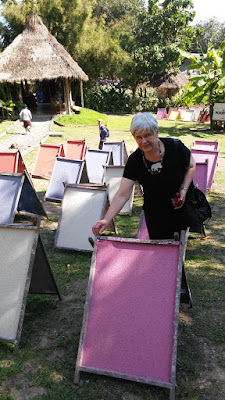
|
|
Poopoo paper on drying racks
|
At the end of the tour, we visitors got to make greeting cards from the finished paper, and since our daughter is expecting our first grandchild, we also bought a picture frame made from the paper. How many other grand kids get to claim that their baby picture was wrapped in PRETTY elephant poo?!
|
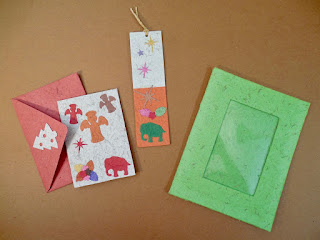
|
|
Greeting card, bookmark, and picture frame
|
Does elephant poo paper work as a foundation for art? Yes it does! Here is my quick experiment with poo paper and oil pastels. The paper is tough, soft, and really nice to work on!
|
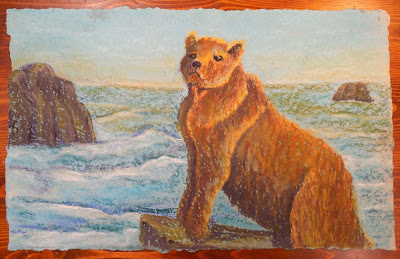
|
|
A bear: oil pastels on elephant poo paper
|
|
|
|
Get an art lesson about Thailand today by clicking on the titles below:
I love paper. As with any art material - brushes, paint, whatever - the quality of the art product helps determine the quality of the project you are completing.
For example, a few years ago I was asked to teach an art class for children at a local youth camp; organizers agreed to provide the art supplies, tables, equipment, and even some volunteers to help the students. All I had to do was teach.
The lesson - based on ArtAchieve’s lesson, “The Kitenge Tree Wall Hanging from Tanzania” - involved painting with watercolors, so I specified my favorite crayons, drawing paper, watercolors, and watercolor brushes. When I arrived to teach, however,
-
the “drawing paper,” was thin printer paper, and
-
the “watercolor brushes” had wiry bristles that were so stiff they tore the paper.
It was too late to get replacement supplies, so I proceeded with the lesson. Students were happily involved as they drew and colored with their crayons, but when they applied watercolors to create a batik effect, the paper started tearing, and soon each student was left with a soggy shredded mess.
An experience like that is a good reminder that the kind of paper we use in an art project is really important; it puts me on a constant lookout for new paper products. It’s fun to see how they affect my art work. So you can imagine how exciting it was when our guide in Thailand drove us to the Elephant Poopoo Paper Park!
|

|
|
Entrance to the Poopoo Paper Park
|
Thailand has 3000 elephants living on elephant farms, and somehow the country needs to pay for their feed. They have enormous appetites. Thai elephants eat grass, and it takes them only 2 hours to digest a meal before it’s bathroom time.
With such a short digestion time, only 40% of the grass is digested; the rest is eliminated. So one way to pay for elephant upkeep is to turn the elephant poo and all that undigested grass into poopoo paper. (That’s poopoo paper for art projects, not for the bathroom!)
It sounds disgusting, though, and our first question was, “Does the paper smell?” The park attendant assured us it did not and then took us on a tour of the park to show us a process whereby Thai people turn poo into paper. The tour was in a park, so industrial scale processing what not what we were going to see. This was a concept tour. Industrial scale production would be taking place elsewhere.
|

|
|
Our park attendant with a lump of dried poo
|
Standing in front of bags of dried poo, the ranger offered us a chance to to feel and smell the read-for-processing poo. To be honest, it seemed pretty inert and really did NOT smell at that point.
So off we went to the next stage of processing: poo washing! During this first stage of the process the poo is boiled, cleaned, and rinsed.

Each of us got a turn stirring the boiling pot. It felt a bit like a scene from Macbeth: "Round about the cauldron go . . .Double, double, toil and trouble, Fire burn, and cauldron bubble!"

When the boiling, washing, and rinsing stages are finished, only the undigested grass fibers remain.
Next, the undigested grass fiber -
-
along with some plant dyes (These paper makers are purists: no chemical dyes or bleaches!)
-
and tough fibers from mulberry trees -
get sloshed together in a big mixing tub. The mulberry fibers add strength to the paper.
|

|
|
A mixing tub with dye and mulberry fiber added to the poo
|
When the slurry is completely blended and pudding-like, the slurry gets spread out on a screen, and the screen with its paper mush coating are set out in the sun to dry.
|

|
|
Poopoo paper on drying racks
|
At the end of the tour, we visitors got to make greeting cards from the finished paper, and since our daughter is expecting our first grandchild, we also bought a picture frame made from the paper. How many other grand kids get to claim that their baby picture was wrapped in PRETTY elephant poo?!
|

|
|
Greeting card, bookmark, and picture frame
|
Does elephant poo paper work as a foundation for art? Yes it does! Here is my quick experiment with poo paper and oil pastels. The paper is tough, soft, and really nice to work on!
|

|
|
A bear: oil pastels on elephant poo paper
|
|
|
|
Get an art lesson about Thailand today by clicking on the titles below:
I love paper. As with any art material - brushes, paint, whatever - the quality of the art product helps determine the quality of the project you are completing.
For example, a few years ago I was asked to teach an art class for children at a local youth camp; organizers agreed to provide the art supplies, tables, equipment, and even some volunteers to help the students. All I had to do was teach.
The lesson - based on ArtAchieve’s lesson, “The Kitenge Tree Wall Hanging from Tanzania” - involved painting with watercolors, so I specified my favorite crayons, drawing paper, watercolors, and watercolor brushes. When I arrived to teach, however,
-
the “drawing paper,” was thin printer paper, and
-
the “watercolor brushes” had wiry bristles that were so stiff they tore the paper.
It was too late to get replacement supplies, so I proceeded with the lesson. Students were happily involved as they drew and colored with their crayons, but when they applied watercolors to create a batik effect, the paper started tearing, and soon each student was left with a soggy shredded mess.
An experience like that is a good reminder that the kind of paper we use in an art project is really important; it puts me on a constant lookout for new paper products. It’s fun to see how they affect my art work. So you can imagine how exciting it was when our guide in Thailand drove us to the Elephant Poopoo Paper Park!
|

|
|
Entrance to the Poopoo Paper Park
|
Thailand has 3000 elephants living on elephant farms, and somehow the country needs to pay for their feed. They have enormous appetites. Thai elephants eat grass, and it takes them only 2 hours to digest a meal before it’s bathroom time.
With such a short digestion time, only 40% of the grass is digested; the rest is eliminated. So one way to pay for elephant upkeep is to turn the elephant poo and all that undigested grass into poopoo paper. (That’s poopoo paper for art projects, not for the bathroom!)
It sounds disgusting, though, and our first question was, “Does the paper smell?” The park attendant assured us it did not and then took us on a tour of the park to show us a process whereby Thai people turn poo into paper. The tour was in a park, so industrial scale processing what not what we were going to see. This was a concept tour. Industrial scale production would be taking place elsewhere.
|

|
|
Our park attendant with a lump of dried poo
|
Standing in front of bags of dried poo, the ranger offered us a chance to to feel and smell the read-for-processing poo. To be honest, it seemed pretty inert and really did NOT smell at that point.
So off we went to the next stage of processing: poo washing! During this first stage of the process the poo is boiled, cleaned, and rinsed.

Each of us got a turn stirring the boiling pot. It felt a bit like a scene from Macbeth: "Round about the cauldron go . . .Double, double, toil and trouble, Fire burn, and cauldron bubble!"

When the boiling, washing, and rinsing stages are finished, only the undigested grass fibers remain.
Next, the undigested grass fiber -
-
along with some plant dyes (These paper makers are purists: no chemical dyes or bleaches!)
-
and tough fibers from mulberry trees -
get sloshed together in a big mixing tub. The mulberry fibers add strength to the paper.
|

|
|
A mixing tub with dye and mulberry fiber added to the poo
|
When the slurry is completely blended and pudding-like, the slurry gets spread out on a screen, and the screen with its paper mush coating are set out in the sun to dry.
|

|
|
Poopoo paper on drying racks
|
At the end of the tour, we visitors got to make greeting cards from the finished paper, and since our daughter is expecting our first grandchild, we also bought a picture frame made from the paper. How many other grand kids get to claim that their baby picture was wrapped in PRETTY elephant poo?!
|

|
|
Greeting card, bookmark, and picture frame
|
Does elephant poo paper work as a foundation for art? Yes it does! Here is my quick experiment with poo paper and oil pastels. The paper is tough, soft, and really nice to work on!
|

|
|
A bear: oil pastels on elephant poo paper
|
|
|
|
Get an art lesson about Thailand today by clicking on the titles below:








